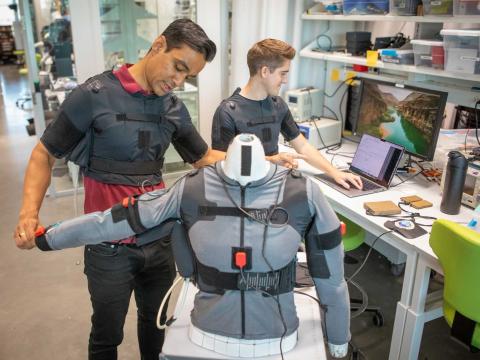AI Will Affect Every Warfighting Function in Indo-Pacific Command
Artificial intelligence (AI) will likely affect every warfighting function in the Indo-Pacific region, according to U.S. military officials, but at the same time, it’s not a one-size-fits-all solution.
That was one takeaway from a panel of military officials currently serving in the region who discussed the modernization of communications, information technology and cyber in the region during the AFCEA TechNet Indo-Pacific conference in Honolulu.
Col. Jared Voneida, USMC, C4 Operations Division chief, U.S. Indo-Pacific Command J63, noted that AI will serve an array of useful purposes for forces in the region.
“It’s gonna hit every single warfighting function,” he said, immediately after mentioning some of those functions. “For INDOPACOM, we're certainly looking for AI, as I mentioned, to speed up the decision cycle, [for] predictive analysis for logistics. We need it for fires, target identification, weapon-to-target pairing.”
Voneida compared AI functions to those of forward air controllers or forward observers, except that AI can perform much more complex missions. “It's similar things that we do in an infantry battalion with a forward air controller and a forward observer. But that's a small, small battle space. You can keep track of that with a kneeboard and in your head with what's going on. This theater is too big. You can't do it with a single person. You can't do it on a PowerPoint slide. You need AI capabilities to help make those decisions faster for you.”
It is up to the government to set the stage for AI’s potential flexibility, he explained.
“As the government, we set the stage for that flexibility within our [combatant commands] and our subordinate commands by having standard data tagging processes and procedures. That way, we can use whatever AI tool we think fits our mission—as long as the backend data is there, it's accessible, it's tagged in a standard way, and it's not stovepiped across service networks,” Voneida said. “So we do that, I think we buy ourselves a lot of flexibility for the commanders to use their prerogative on what tools benefit them, and it gives us a lot of flexibility to pivot to certain industry partners when we want to leverage one capability over the next. Having that foundation in place, all the data that feeds into the AI, that's the homework that we need to do right now.”
He added that preferences change with new capabilities, but establishing that base is essential. “We've kind of changed which tools we like over the last few years as more and more capabilities become mature, but setting that foundation, I think, is key for us.
Col. Toby Hlad, USMC, Defense Information Systems Agency (DISA) Pacific, said that Voneida’s comments were spot-on. “PACOM’s an AI-enabled headquarters? This is an AI-enabled theater. There are multiple opportunities for AI, large language models, to be integrated at multiple echelons. It's not just the combatant commands; it's the components down to the lower echelons,” he declared. Different AI tools and capabilities work best for different things, so let's take the best of breed for that right echelon.”
As one example of AI’s capabilities, Hlad said it can be used to search a recorded meeting for guidance offered by Adm. Samuel Paparo, Indo-Pacific Command commander. “It helps us go faster as a staff, as a theater.”
He also noted the value of AI for cybersecurity. “From a DISA perspective, how are we doing AI-enabled defensive cyber operations for multiple enclaves? For a CSSP [cyber security service provider] that's important,” he said before suggesting the technology may also research the history of fiber cuts in a particular country to look for patterns. “So, we can be a little more predictive for maneuver in the theater, for the DISN [Defense Information Systems Network] and our defensive efforts. Helping us go faster and integrating that is something we're looking for from a defensive side and a network operation side and just a provisioning side.”
Col. Brett Cochran, commander, 613th Air Operations Center, said the operations center is prototyping AI capabilities.
He reported working with industry to develop a data layer. “We're testing that, or exercising with that, making sure that we can get cloud capability and those kinds of things, and it's been working great—very, very happy with that.
While some modernization is done from a top-down approach, a bottom-up approach is also useful, Cochran noted. “There's the top-down approach that acquisitions and our program offices do to modernize us, but we also have a grassroots level where we can inform the bigger picture,” he said. “They're looking at the global modernization, but we have unique needs as well.
AI, to me, it brings back memories of when Lean Six Sigma was a cool thing, and we tried to smear it all over everything, and it wasn't always appropriate for everything we tried to apply it to.
Brig. Gen. Ray Phariss, USA, commanding general, 311th Signal Command (Theater), cautioned that while AI can be useful, it should be deployed carefully. “AI, to me, it brings back memories of when Lean Six Sigma was a cool thing, and we tried to smear it all over everything, and it wasn't always appropriate for everything we tried to apply it to. AI is similar in that it's not a one-size-fits-all,” the general said.
The 311th Signal Command, however, is exploring the technology’s possibilities. “It can do anything from helping you write better papers to making really complex decisions with a lot of data-based factors, really quickly. Across the department, there's a focus on improving and expanding our understanding of what AI is and how it's different than machine learning.”
The applications are many, and AI will likely be most useful for complex decisions requiring a lot of different data sources. “I think there's almost unlimited applications for it, but you need to know what you're doing before you start. And I would say the problem sets that are the most attractive for this are going to be those where it's a very complex decision [and] we need to bring in a lot of different data and make quick decisions,” Phariss offered.
Still, some caution is required, he suggested. “In this area, the answer you get very much depends upon the specific question you ask. So, you’ve got to get really good at asking the right question, because if your question is bad, the answer is going to be bad. And I agree with Jared that even if you're asking the perfect question and your dataset's not right, you're still going to get a bad answer because you don't have the right data.”
The commander mentioned the Army’s Vantage flexible data platform that uses a suite of curated tools to offer soldiers a common operating picture capable of tracking essential functions and enabling analysis, and he noted that AI capabilities leverage that data. “Vantage is a current tool that we're using. It's not so much AI. It's more of a dataset that pulls together data from a lot of different other sources, but it's a critical step needed to then overlay some AI or machine learning tool on top of that,” Phariss explained. “This is a rapidly expanding area. I would just say we need to be very careful and deliberate and with a high degree of self-awareness on what we try to apply this to. Otherwise, you've got the potential to waste a lot of time, money and effort and not get a good outcome on it.”
TechNet Indo-Pacific is organized by AFCEA International and AFCEA Hawaii. SIGNAL Media is the official media of AFCEA International.




Comments